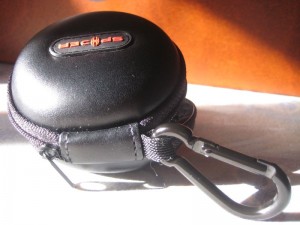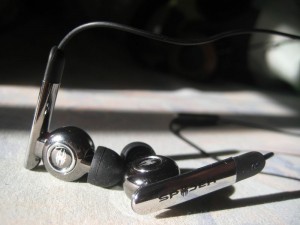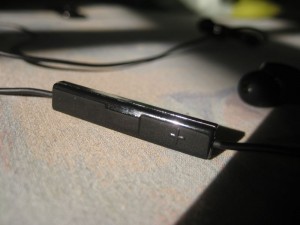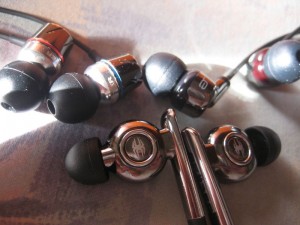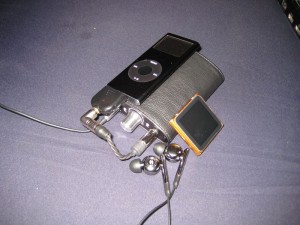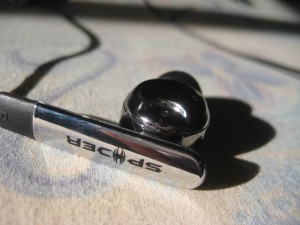The folks over at Spider Cable were kind enough to send me their first foray into the headphone arena, the Real Voice IEM. I got it as a review unit and paid $20 taxes at customs when I picked it up for review.
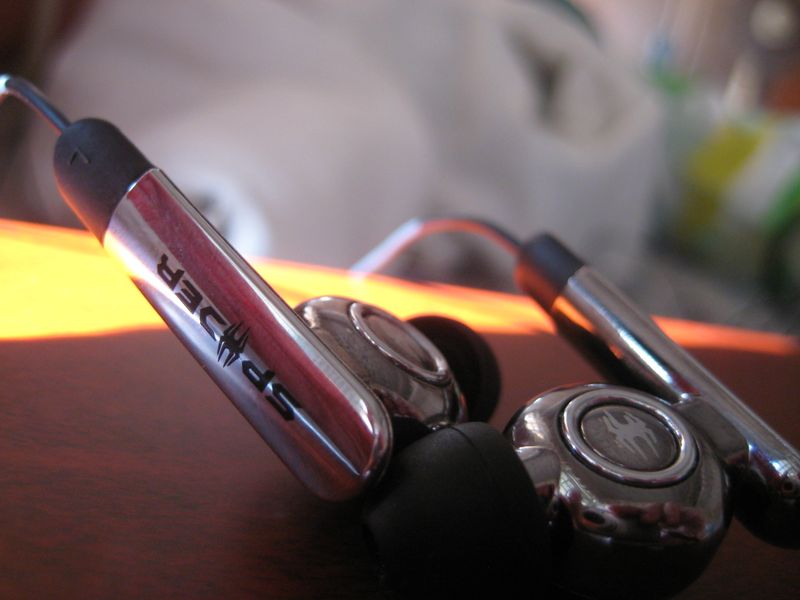
Now, Spider Cable is not a well-known company as of the moment. But I can easily see that changing with the Spider Real Voice. A company's first product in a field often will determine whether they will make it or not, and after trying out the Real Voice for the past couple of weeks, I can safely say that, if more people got to hear this gem of an IEM from a total newcomer to the field, this just might catch on.
The Packaging
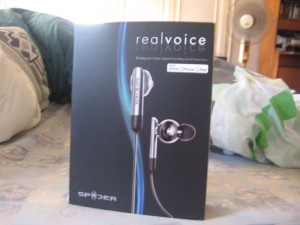 A Cheap Cardboard Box... I received the Real Voice in a black cardboard box. It is was very light and did not have much heft to it. Opening it, there really wasn't anything inside except for another black cardboard box with a light magnetic flap that opens to reveal the components.
A Cheap Cardboard Box... I received the Real Voice in a black cardboard box. It is was very light and did not have much heft to it. Opening it, there really wasn't anything inside except for another black cardboard box with a light magnetic flap that opens to reveal the components.
Inside you will find the IEM itself, a nice small hardcase, a bunch of Small, Medium and Large tips, a silicon bi-flange, a shirt clip, and wonder of wonders, a carbiner!
The Carbiner by the way works great at clipping onto the hardcase and attaching to your belt hooks or whatever other handy clippable article you have on hand. It's very convenient for keeping the Real Voice handy. I like that I can fit an iPod Nano 6G into the case along with the Real Voice, it truly makes for a portable audio solution in a case that you can take with you anywhere.
All in all, the packaging is pretty mediocre, it obviously took some cues from the way Monster packages their IEMs like the Beats Tours and the Turbine series, but clearly not much money was spent on this. That works for me, I'm not paying for the packaging, I want the earphones! The packed in accessories are excellent, a carbiner and a nice case are more than enough. Tip selection is standard with the only thing above the norm being the inclusion of the bi-flanges. As of this writing, Spider Cable has now offered a new "medium large" tip for those who couldn't get a good fit with the medium and large tips, and will send the intermediary tip free of charge to those who have the Real Voice.
Fit and Build
IEMs are all about portability, and when you think portable a few qualities are important. First of all is durability: many people use IEMs for their day-to-day business around town, including commutes, work outs, jogging, basically taking their IEMs with them everywhere as is the in-thing in the iPod generation. Is your new audio gateway going to pass the test of ruggedness?
 Mini Plug... it works with iPhones!
Mini Plug... it works with iPhones!
The Real Voice, sadly, is not at all confidence-inspiring in this aspect. The cables are the typical rubber kind, but are thin and wiry, with no strain reliefs at the IEM housing. There is a standard rubber strain relief at the plug, but other than that the cables look thin and unprotected and prone to breaking. Worse, the thin cables have a bad memory effect and are very prone to tangling, which is one of my pet peeves.
The cable quality is even worse than the Monster Turbines (the original, vanilla version) which I honestly hated, and which broke on me twice already at the plug and at right channel. Easily remedied by a recable for those who are technically inclined, but not everyone is. For the average consumer, I would have to caution against these cables and be sure to treat them with care. My friend for instance broke her Turbines within 7 months of use the first round, and her replacement broke in another three. These look even more vulnerable.
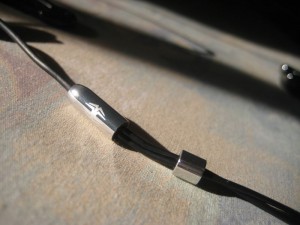 At the Y-Intersect you can solve for X... That said, the finish looks reasonably nice, it's basically plastic with a chrome silver finish. The Spider logo and texts are in a fine white print. At the intersection of the Y-Split you will find a nice chrome chin slider as well. All in all, the Real Voice is pretty nice to look at, but it clearly feels like plastic, which could be good or bad. The quality of the finish is similar to the plastic coated with paint that you find on the plastic parts of old Japanese die-cast models with plastic fittings. From experience, I know that the paint fades under the plastic finish and the result isn't very nice, but this won't be for years, maybe more if you take care of the set.
At the Y-Intersect you can solve for X... That said, the finish looks reasonably nice, it's basically plastic with a chrome silver finish. The Spider logo and texts are in a fine white print. At the intersection of the Y-Split you will find a nice chrome chin slider as well. All in all, the Real Voice is pretty nice to look at, but it clearly feels like plastic, which could be good or bad. The quality of the finish is similar to the plastic coated with paint that you find on the plastic parts of old Japanese die-cast models with plastic fittings. From experience, I know that the paint fades under the plastic finish and the result isn't very nice, but this won't be for years, maybe more if you take care of the set.
As for fit, I was pleasantly surprised. The Real Voice is the largest universal IEM I have ever seen, bar none. And I've been around the block. They are even larger than the Triple.Fi 10s, which were very unwieldy, and because of this I had a lot of reservations when I took these out of the box. However, upon trying them with the stock medium tips, I am happy to say that they fit almost perfectly! They don't fall out, they keep their seal even through strenuous activity like jogging, even without using the shirt clip. This is a godsend! Often I had to deal with issues with a lot of other IEMs. The Turbines for instance always kept falling out of my ear no matter what tip I used, and could never keep their seal whether I used deep insertion or now.
The Real Voice, though is very comfortable with deep insertion -- the medium tips are pretty small and slide all the way into my ear canal. This gives them a great seal, and the seal doesn't go away no matter how much I bob or shake my head. Isolation is pretty good, not total isolation but I have yet to hear an IEM that really accomplished this. With music on you will not hear anything except the loudest and deepest noises (like plain engines). These block out even my car's engine and road noise (car is pretty new though and not too noisy). But please don't tell anyone I was driving with these on.
I attribute the good fit to the light weight of these IEMs. They are big, but since they are all plastic, they weigh next to nothing. The Turbines, though smaller, are much heavier and just tend to fall out of my ear. In case you can't get a fit with teh stock tips (which would be sad) you can swap in any tip that is of the "large nozzle size" -- like all of Monster's tips, or the Comply T400 series. The newer Shure tips (and Olives) will not fit or the tips from the UM3X.
I also have one more major concern, which is the control talk module. The module comes out on the right side and has the standard talk, volume up and volume down buttons. On an iPhone pressing Talk will take calls and let you use it as a mouthpiece, but when no calls are playing will pause the track with a single press, move forward with two and back with three.
The problem is the buttons are hard to press. They are very shallow, close to each other, and don't distinguish well. Many times I pressed the talk button when I was trying to hit the volume buttons, and double pressing put me into the next track. The volume buttons also aren't at the edges, you need a bit in the middle where the plus and minus engravings are found, and these easily put you into the talk button's territory. Since the talk button is not a separate metal piece and part of one long plastic slab, it often gets hit with the splash damage. All in all, a very inferior module to what is used on Monster Beats cables, and many other control talk modules I've seen. Not a dealbreaker for sure, and it's nice to have the functionality there, but I wish it had been executed better.
The Sound
Now, to the real meat of this review. The all important sound! There is no doubt that you will be using these to listen to music, so a hint: this should be the part of the review you should be paying attention to!
The Real Voice is supposed to ship with a country music CD from the artists Nik and Sam, but unfortunately due to copyright reasons I was not given a copy, as I live outside the US. Spider Cable was supposed to have us test the Real Voice using the tracks on this CD, and I am thinking they are very vocal-oriented tracks that showcase the Real Voice's strengths. But more on that later. End thing, Spider Cable asked to review these with some vocal tracks and to compare them with a few other IEM rivals.
As a result, I decided to test the Real Voice on my own favorite vocal tracks. These include songs from Dave Matthew's Band, always my go-to recordings for their great vocals, the complicated drum work that reveals strengths in the treble area, jazzy and soulful sound and all-around great quality in the recording. For some female pizazz I opted to use Ive Mendes with her sexy deep voice and latin sound. To round out my usual listening genres and tastes I added some Hed Kandi music from Wez Clarke and Maxine Hardcastle to get a feel for the bass beats and club sound, and finally a round of acoustic guitar from Andy McKee.
The setup I used was an iPod Nano 6G direct playing 320kbps MP3s, and an iPod Nano 2G with a Mundorf LOD going into a C&C X02 Tube Amp. As worthy rivals, I put them up directly against my favorite $50 IEM, the Ultimate Ears Metro.Fi 220, and bass stalwart Monster Turbines. I should note that the MF220, while no longer in production, used to retail for a little under $100 which is about the same as Real Voice, and the Turbines, while usually available for $50 today from the Monster Outlet Store refurbished, originally retailed for $179.
Basic Sound Signature
I really love the Real Voice! It is basically a mids-oriented IEM, and this is likely why it is called the Real Voice. Vocals are really, really good on these; the best I have ever heard on a dynamic driver IEM. They float out above the rest of the sound, and have a very dreamy, laidback feel to them. But make no mistake, the mids are not recessed; as I said they are quite a mids-focused IEM. There is a clear mids emphasis, but it doesn't sound like the typical reversed "V" sound you get on an elevated-mids frequency curve. I attribute this to the strong bass emphasis. These may be mid-focused, but the bass is no slouch by any means. The last set I reviews, the Miu Audio MR2, was a heavy-bass set not unlike the Hippo Boom, which by its name was a supreme mid-bass monster. The Real Voice does not approach taht kind of territory. There is good midbass but the midbass is not too strong that it overshadows the mids, instead it simply is there to provide enough warmth and body to the sound.
However, the sub bass on these is something else. They reach down deep and give a good adequate rumbly kick to the sound. It is far superior to the Hippo VB in this respect, by far. The bass is very comparable to the Monster Turbines with a good seal. However, I would say the Turbines have a bit more midbass whereas the Real Voice is slightly softer in this area, but superior in the sub bass that gives that deep rumble.
Another great thing about these is that they have absolutely no grain. These are the smoothest IEMs I have heard in the $100 range. Period. There is no trace of harshness whatsoever, no matter which recording I tried. The DBA-02 and the B2, for instance, tend to sound very shrill and piercing on Dave Matthew's Band recordings (Carter Beauford loves his high hats and cymbals) and these two IEMs are all but unlistenable to me on DMB tracks. The Real Voice though mercifully softens the edge on these tracks and makes listening a great pleasure. I should also note that the smooth, wispy sound of the Real Voice extends all around, making the treble sound ethereal and the bass enveloping, the mids and vocals caressing. These are a very smooth IEM and a joy to listen to.
On the other hand, we come to what will be the main weakness of these IEMs for many people -- the treble. The treble is "okay" but in audiophilia "okay" is never good enough. The trebles are quite rolled off and there is no air in the upper registers. It's all smooth and euphonic but there is no extension. Those of you who like sizzling, crispy cymbals, you are not going to get them here.
In terms of detail, for a $90 dynamic IEM they are pretty good, but they do not approach the detail retrieval of the GR07 or the better double/triple/quadruple armature offerings. The sound all in all has a veneer of milky creamy silk all over it and this may seem to smoothen out the detail a bit. Take that as you will, but I would like to emphasize that these are not veiled or muddy by any stretch (like, say, the Vmoda Vibe or the Fisher Eternas). They are just smooth. They are not detail kings, but that's not what these are going for as far as I can tell.
In a nutshell, they are a smooth, euphonic IEM that really brings vocals to life but not at the expense of thin, harsh sound. They have ample warmth and bass and a slightly rolled-off treble.
One last note about the sound: the soundstage on these is surprisingly good. They do not have air on the upper end but soundstaging is quite wide, quite similar to the IE8 actually with a convincing surround ear field. I can attribute this perhaps to the vented driver design, which in addition is most likely responsible for the excellent bass reproduction.
I find myself greatly enjoying the soundstage of these IEMs, which is far superior to that of the Turbines, which are very closed in and congested, and the MF220 which was too narrow.
One weakness though is that the Real Voice has a tendency to "smear' sounds together. The soundstage is suitably wide but instrument separation is not very good, even amped. The MF220, although not as impressive, has better separation. With the Real Voice, although there was some good depth to the sound field, the sounds sometimes tend to "line up" together rather than be their own separate, distinct entities. The rich sound I suppose makes it difficult for the sounds to really be well-separated.
Some Quick Tracks by Track Comparisons
Dave Mattew's Band - Satellite (Under the Table and Dreaming) - the busy nature of this track, with violins, sax, drums, vocals and various percussion instruments makes these really ideal to test separation.
Ive Mendes - Voce - this is a latin groove with a good bass beat, bongos, light drums, guitar and luscious vocals from Ive.
Maxine Hardcastle - Bringing me Back (Hed Kandi Beach House 2009) - this is a sensual female vocal club track a strong electronic house beat and crisp synth drums, bongos and keyboard work.
Andy McKee - Gates of Gnomeria (Gates of Gnomeria) - a melancholy, adventurous guitar solo with a haunting melody evoking a foggy river through a dense forest before seeing sunlight at the midpoint with a more joyous and lively sound of knocking on the guitar's wooden body.
Overall, I think I preferred the Real Voice to the competition in all of these tracks. It's really just that good. Although a bit rolled-off in the treble, it handily beat the others where it counted, especially in the mids where the vocals and solo guitar work really shine. Using some other tracks in some other genres I am thinking the Turbines may have taken these, but then I am not sure. The Real Voice is clearly a cut above both the Turbines and the Metro.Fi's. I was almost suprised that the Real Voice outperformed the Turbines in the Hed Kandi tracks, but then I think about the awesome bass of the Real Voice and I realize that this shouldn't have come as a surprise; the Real Voice has all the strengths of the Turbines when it comes to bass but in addition has incredible mids to go with them. The Real Voice would only lose if you prefer crisper or hotter highs, which the Real Voice lacks.
In fact, I would say the Real Voice is clearly a cut above the Turbines in the same way the Turbine Pro models are. And actually, I would say the Real Voice compares really closely to the Turbine Coppers. Although did not pit the two together in this review, the Real Voice is very close to the Golds and Coppers. Closer to the Coppers actually, as the Golds have a bit more mid-bass. But the mids of these are comparable, and actually I think better than the Golds, and a bit different from the Coppers. Coppers still seem to hold an edge in detail retrieval but otherwise the Real Voice's vocal presentation is superior. All of that, and with a better fit to boot! At least to my ears.
I wish I could compare them to the Miles Davis, which I have yet to hear. But they compare favorably even to the Coppers, which are more than three times their price. I also prefer them to the JVC FX500 and FX700, which are great but ultimately the treble is not to my tastes as these tend to get too crisp and sometimes harsh. The Real Voice has absolutely no harshness no matter what I do with them or what I feed them. I also prefer them to the IE8, which while an awesome and venerable IEM, is getting a little long in the tooth, and these have all the same comfort and similar soundstage (that I missed going to the Turbine models).
Final Recommendation
I would like to end this review saying that this is one of the finest dynamic driver IEMs I have ever heard, at any price. That they go for $90 is mind-boggling. These are really, really good. They will suit those that want a bassy, laidback signature with great emphasis on mids and a very smooth, sound.
They are most comparable to the Turbine Golds or Coppers, at far below the price. If you can live with the cheap-looking construction and especially the thin, tangly cables, these are a real winner and I have to take my hat off to Spider Cable for managing such a feat on their very first attempt.
A final thank you to Spider Cable for giving me the opportunity to review this awesome piece of kit. These are, indeed, for real and I wish Spider Cable all the luck in their foray into the headphone world.

Now, Spider Cable is not a well-known company as of the moment. But I can easily see that changing with the Spider Real Voice. A company's first product in a field often will determine whether they will make it or not, and after trying out the Real Voice for the past couple of weeks, I can safely say that, if more people got to hear this gem of an IEM from a total newcomer to the field, this just might catch on.
The Packaging

Inside you will find the IEM itself, a nice small hardcase, a bunch of Small, Medium and Large tips, a silicon bi-flange, a shirt clip, and wonder of wonders, a carbiner!
The Carbiner by the way works great at clipping onto the hardcase and attaching to your belt hooks or whatever other handy clippable article you have on hand. It's very convenient for keeping the Real Voice handy. I like that I can fit an iPod Nano 6G into the case along with the Real Voice, it truly makes for a portable audio solution in a case that you can take with you anywhere.
All in all, the packaging is pretty mediocre, it obviously took some cues from the way Monster packages their IEMs like the Beats Tours and the Turbine series, but clearly not much money was spent on this. That works for me, I'm not paying for the packaging, I want the earphones! The packed in accessories are excellent, a carbiner and a nice case are more than enough. Tip selection is standard with the only thing above the norm being the inclusion of the bi-flanges. As of this writing, Spider Cable has now offered a new "medium large" tip for those who couldn't get a good fit with the medium and large tips, and will send the intermediary tip free of charge to those who have the Real Voice.
Fit and Build
IEMs are all about portability, and when you think portable a few qualities are important. First of all is durability: many people use IEMs for their day-to-day business around town, including commutes, work outs, jogging, basically taking their IEMs with them everywhere as is the in-thing in the iPod generation. Is your new audio gateway going to pass the test of ruggedness?

The Real Voice, sadly, is not at all confidence-inspiring in this aspect. The cables are the typical rubber kind, but are thin and wiry, with no strain reliefs at the IEM housing. There is a standard rubber strain relief at the plug, but other than that the cables look thin and unprotected and prone to breaking. Worse, the thin cables have a bad memory effect and are very prone to tangling, which is one of my pet peeves.
The cable quality is even worse than the Monster Turbines (the original, vanilla version) which I honestly hated, and which broke on me twice already at the plug and at right channel. Easily remedied by a recable for those who are technically inclined, but not everyone is. For the average consumer, I would have to caution against these cables and be sure to treat them with care. My friend for instance broke her Turbines within 7 months of use the first round, and her replacement broke in another three. These look even more vulnerable.

As for fit, I was pleasantly surprised. The Real Voice is the largest universal IEM I have ever seen, bar none. And I've been around the block. They are even larger than the Triple.Fi 10s, which were very unwieldy, and because of this I had a lot of reservations when I took these out of the box. However, upon trying them with the stock medium tips, I am happy to say that they fit almost perfectly! They don't fall out, they keep their seal even through strenuous activity like jogging, even without using the shirt clip. This is a godsend! Often I had to deal with issues with a lot of other IEMs. The Turbines for instance always kept falling out of my ear no matter what tip I used, and could never keep their seal whether I used deep insertion or now.
The Real Voice, though is very comfortable with deep insertion -- the medium tips are pretty small and slide all the way into my ear canal. This gives them a great seal, and the seal doesn't go away no matter how much I bob or shake my head. Isolation is pretty good, not total isolation but I have yet to hear an IEM that really accomplished this. With music on you will not hear anything except the loudest and deepest noises (like plain engines). These block out even my car's engine and road noise (car is pretty new though and not too noisy). But please don't tell anyone I was driving with these on.
I attribute the good fit to the light weight of these IEMs. They are big, but since they are all plastic, they weigh next to nothing. The Turbines, though smaller, are much heavier and just tend to fall out of my ear. In case you can't get a fit with teh stock tips (which would be sad) you can swap in any tip that is of the "large nozzle size" -- like all of Monster's tips, or the Comply T400 series. The newer Shure tips (and Olives) will not fit or the tips from the UM3X.
I also have one more major concern, which is the control talk module. The module comes out on the right side and has the standard talk, volume up and volume down buttons. On an iPhone pressing Talk will take calls and let you use it as a mouthpiece, but when no calls are playing will pause the track with a single press, move forward with two and back with three.
The problem is the buttons are hard to press. They are very shallow, close to each other, and don't distinguish well. Many times I pressed the talk button when I was trying to hit the volume buttons, and double pressing put me into the next track. The volume buttons also aren't at the edges, you need a bit in the middle where the plus and minus engravings are found, and these easily put you into the talk button's territory. Since the talk button is not a separate metal piece and part of one long plastic slab, it often gets hit with the splash damage. All in all, a very inferior module to what is used on Monster Beats cables, and many other control talk modules I've seen. Not a dealbreaker for sure, and it's nice to have the functionality there, but I wish it had been executed better.
The Sound
Now, to the real meat of this review. The all important sound! There is no doubt that you will be using these to listen to music, so a hint: this should be the part of the review you should be paying attention to!
The Real Voice is supposed to ship with a country music CD from the artists Nik and Sam, but unfortunately due to copyright reasons I was not given a copy, as I live outside the US. Spider Cable was supposed to have us test the Real Voice using the tracks on this CD, and I am thinking they are very vocal-oriented tracks that showcase the Real Voice's strengths. But more on that later. End thing, Spider Cable asked to review these with some vocal tracks and to compare them with a few other IEM rivals.
As a result, I decided to test the Real Voice on my own favorite vocal tracks. These include songs from Dave Matthew's Band, always my go-to recordings for their great vocals, the complicated drum work that reveals strengths in the treble area, jazzy and soulful sound and all-around great quality in the recording. For some female pizazz I opted to use Ive Mendes with her sexy deep voice and latin sound. To round out my usual listening genres and tastes I added some Hed Kandi music from Wez Clarke and Maxine Hardcastle to get a feel for the bass beats and club sound, and finally a round of acoustic guitar from Andy McKee.
The setup I used was an iPod Nano 6G direct playing 320kbps MP3s, and an iPod Nano 2G with a Mundorf LOD going into a C&C X02 Tube Amp. As worthy rivals, I put them up directly against my favorite $50 IEM, the Ultimate Ears Metro.Fi 220, and bass stalwart Monster Turbines. I should note that the MF220, while no longer in production, used to retail for a little under $100 which is about the same as Real Voice, and the Turbines, while usually available for $50 today from the Monster Outlet Store refurbished, originally retailed for $179.
Basic Sound Signature
I really love the Real Voice! It is basically a mids-oriented IEM, and this is likely why it is called the Real Voice. Vocals are really, really good on these; the best I have ever heard on a dynamic driver IEM. They float out above the rest of the sound, and have a very dreamy, laidback feel to them. But make no mistake, the mids are not recessed; as I said they are quite a mids-focused IEM. There is a clear mids emphasis, but it doesn't sound like the typical reversed "V" sound you get on an elevated-mids frequency curve. I attribute this to the strong bass emphasis. These may be mid-focused, but the bass is no slouch by any means. The last set I reviews, the Miu Audio MR2, was a heavy-bass set not unlike the Hippo Boom, which by its name was a supreme mid-bass monster. The Real Voice does not approach taht kind of territory. There is good midbass but the midbass is not too strong that it overshadows the mids, instead it simply is there to provide enough warmth and body to the sound.
However, the sub bass on these is something else. They reach down deep and give a good adequate rumbly kick to the sound. It is far superior to the Hippo VB in this respect, by far. The bass is very comparable to the Monster Turbines with a good seal. However, I would say the Turbines have a bit more midbass whereas the Real Voice is slightly softer in this area, but superior in the sub bass that gives that deep rumble.
Another great thing about these is that they have absolutely no grain. These are the smoothest IEMs I have heard in the $100 range. Period. There is no trace of harshness whatsoever, no matter which recording I tried. The DBA-02 and the B2, for instance, tend to sound very shrill and piercing on Dave Matthew's Band recordings (Carter Beauford loves his high hats and cymbals) and these two IEMs are all but unlistenable to me on DMB tracks. The Real Voice though mercifully softens the edge on these tracks and makes listening a great pleasure. I should also note that the smooth, wispy sound of the Real Voice extends all around, making the treble sound ethereal and the bass enveloping, the mids and vocals caressing. These are a very smooth IEM and a joy to listen to.
On the other hand, we come to what will be the main weakness of these IEMs for many people -- the treble. The treble is "okay" but in audiophilia "okay" is never good enough. The trebles are quite rolled off and there is no air in the upper registers. It's all smooth and euphonic but there is no extension. Those of you who like sizzling, crispy cymbals, you are not going to get them here.
In terms of detail, for a $90 dynamic IEM they are pretty good, but they do not approach the detail retrieval of the GR07 or the better double/triple/quadruple armature offerings. The sound all in all has a veneer of milky creamy silk all over it and this may seem to smoothen out the detail a bit. Take that as you will, but I would like to emphasize that these are not veiled or muddy by any stretch (like, say, the Vmoda Vibe or the Fisher Eternas). They are just smooth. They are not detail kings, but that's not what these are going for as far as I can tell.
In a nutshell, they are a smooth, euphonic IEM that really brings vocals to life but not at the expense of thin, harsh sound. They have ample warmth and bass and a slightly rolled-off treble.
One last note about the sound: the soundstage on these is surprisingly good. They do not have air on the upper end but soundstaging is quite wide, quite similar to the IE8 actually with a convincing surround ear field. I can attribute this perhaps to the vented driver design, which in addition is most likely responsible for the excellent bass reproduction.
I find myself greatly enjoying the soundstage of these IEMs, which is far superior to that of the Turbines, which are very closed in and congested, and the MF220 which was too narrow.
One weakness though is that the Real Voice has a tendency to "smear' sounds together. The soundstage is suitably wide but instrument separation is not very good, even amped. The MF220, although not as impressive, has better separation. With the Real Voice, although there was some good depth to the sound field, the sounds sometimes tend to "line up" together rather than be their own separate, distinct entities. The rich sound I suppose makes it difficult for the sounds to really be well-separated.
Some Quick Tracks by Track Comparisons
Dave Mattew's Band - Satellite (Under the Table and Dreaming) - the busy nature of this track, with violins, sax, drums, vocals and various percussion instruments makes these really ideal to test separation.
- Real Voice - puts the sounds around you and it's a great concert effect. Dave Matthew's vocals come out along with his backing vocals really well. Sounds do sound close to each other but are not particularly bad in the smearing.
- MF220 - the busy nature of the this track works well with the MF220's separation, but the sound stage was very flat in comparison to the Real Voice. The V-Shape sound of the MF220 really put Dave's voice in the background where it gets lost amidst all the instruments.
- Turbines - Much harder, crisp sound compared to the Real Voice. This track doesn't play particularly well to the Turbine's strengths, which is its bass.
Ive Mendes - Voce - this is a latin groove with a good bass beat, bongos, light drums, guitar and luscious vocals from Ive.
- Real Voice - Ive's voice is fantastic, as are the bongos which really shine on the Real Voice. The low female bongo has a rich timber, although the male pop is not as pronounced as I would. However on the Real Voice the bongos and vocals take centerstage, well supported by the bass. The guitar is just accompaniment in the background.
- MF220 - sounds really great, and I remember I loved the MF220 because of Ive Mendes. However the Real Voice is better at presenting the vocals and the bongos. On the MF220 the drums (especially the cymbals) come out better and more center-stage, and the bass hits me with more intensity. Guitars of this track come out best among the three, but are still a bit understated compared to the voice, but outshine the bongos when they are there.
- Turbines - Ive's voice comes out well and the bass beats are very well-defined. Bongos however don't sound as convincing especially the female bongo. All in all not a good track for the Turbines at all.
Maxine Hardcastle - Bringing me Back (Hed Kandi Beach House 2009) - this is a sensual female vocal club track a strong electronic house beat and crisp synth drums, bongos and keyboard work.
- Real Voice - really good. The wispy vocals have an ethereal quality on these, and the sub bass hits hard and deep. The Real Voice proves to be great not just at acoustic-sounding titles but also on electronic ones. The drums don't sound very good on these and surprisingly the bongos are relegated to the background unlike with the Ive Mendes track. But the vocals are really good and float out even in this busy, bass-driven track.
- MF220 - the heavy bass sound is suitably grooving on the MF220. The vocals on these are wispy but come out really well on the MF220. The crisp sound of the MF220 lends a great quality to the drum work on this one.
- Turbines - similar to the MF220's performance, but just better in every way. This is the kind of music the Turbines shines on and it shows. Bongos are put to the background but the synth keyboard and bass beats are incredible. Vocals are "there" and give the necessary sensual quality but seem like an instrument amongst the synths, which works well with this genre, but I somehow end up missing the vocal presentation of the Real Voice even though the Turbines does a lot of other things better. Also, while there is more mid bass boom, the Real Voice's overall bass was still better.
Andy McKee - Gates of Gnomeria (Gates of Gnomeria) - a melancholy, adventurous guitar solo with a haunting melody evoking a foggy river through a dense forest before seeing sunlight at the midpoint with a more joyous and lively sound of knocking on the guitar's wooden body.
- Real Voice - the rich sound gives body and weight to the guitars, and there's a lot of weight in the low bass. These give the Gates a sad, almost tearful and dreary sound, very heavy on the emotions.
- MF220 - The livelier and more complex passages near the middle and end of the track come out well on the MF220. However the mids just aren't as good on the MF220 as they are on the Real Voice. The guitar work is muted and not impressive at all in comparison. The guitar feels very distant and forlorn.
- Turbines - The dark, foreboding sound quality of the initial movement isn't there the way it came out on the Real Voice. The Turbines are too bright with respect to how it presents the earlier passage! Not to say the Turbines are bright... they are still bassy, but the treble is pretty bright which gives a whole different shade and tone to this track.
Overall, I think I preferred the Real Voice to the competition in all of these tracks. It's really just that good. Although a bit rolled-off in the treble, it handily beat the others where it counted, especially in the mids where the vocals and solo guitar work really shine. Using some other tracks in some other genres I am thinking the Turbines may have taken these, but then I am not sure. The Real Voice is clearly a cut above both the Turbines and the Metro.Fi's. I was almost suprised that the Real Voice outperformed the Turbines in the Hed Kandi tracks, but then I think about the awesome bass of the Real Voice and I realize that this shouldn't have come as a surprise; the Real Voice has all the strengths of the Turbines when it comes to bass but in addition has incredible mids to go with them. The Real Voice would only lose if you prefer crisper or hotter highs, which the Real Voice lacks.
In fact, I would say the Real Voice is clearly a cut above the Turbines in the same way the Turbine Pro models are. And actually, I would say the Real Voice compares really closely to the Turbine Coppers. Although did not pit the two together in this review, the Real Voice is very close to the Golds and Coppers. Closer to the Coppers actually, as the Golds have a bit more mid-bass. But the mids of these are comparable, and actually I think better than the Golds, and a bit different from the Coppers. Coppers still seem to hold an edge in detail retrieval but otherwise the Real Voice's vocal presentation is superior. All of that, and with a better fit to boot! At least to my ears.
I wish I could compare them to the Miles Davis, which I have yet to hear. But they compare favorably even to the Coppers, which are more than three times their price. I also prefer them to the JVC FX500 and FX700, which are great but ultimately the treble is not to my tastes as these tend to get too crisp and sometimes harsh. The Real Voice has absolutely no harshness no matter what I do with them or what I feed them. I also prefer them to the IE8, which while an awesome and venerable IEM, is getting a little long in the tooth, and these have all the same comfort and similar soundstage (that I missed going to the Turbine models).
Final Recommendation
I would like to end this review saying that this is one of the finest dynamic driver IEMs I have ever heard, at any price. That they go for $90 is mind-boggling. These are really, really good. They will suit those that want a bassy, laidback signature with great emphasis on mids and a very smooth, sound.
They are most comparable to the Turbine Golds or Coppers, at far below the price. If you can live with the cheap-looking construction and especially the thin, tangly cables, these are a real winner and I have to take my hat off to Spider Cable for managing such a feat on their very first attempt.
A final thank you to Spider Cable for giving me the opportunity to review this awesome piece of kit. These are, indeed, for real and I wish Spider Cable all the luck in their foray into the headphone world.



